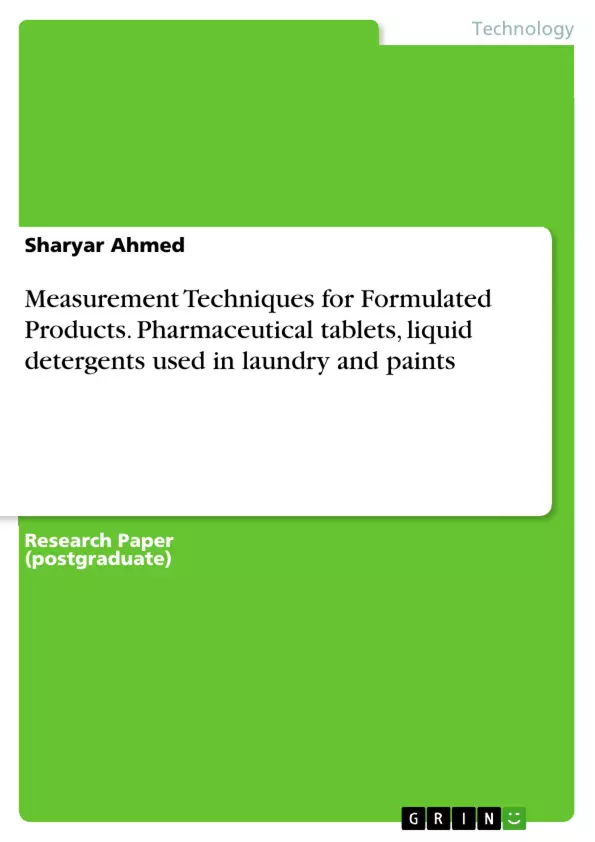In defining "formulation,” one may consider it as the blending of a different compound that is not- reactionary among themselves to ultimately get a combination that bears some specific characteristics (Conte et al, 2011). Its key importance is the assembling of different components in suitable structures and relationships based on a certain combination formula. A combination of these compounds is made based on a products' standard.
Various products are considered to be made out of a combination of various elements. These products include; paints, food, medicinal tablets, and liquid detergents among others. These products are made out of a combination of various products in a certain proportion that is considered in the formulation. Product designs, therefore, focus much on the results of the combination of various materials. In this case, the formulation is developed systematically under the following five-step:
- Stipulate the end quality that is to be obtained.
- Identify data required to gather the composition of raw materials, the cost, and the qualities.
- Determine the processing variables to be used including the raw materials limits.
- Identify the methodology to use including; experimental design, linear programming, and quantitative techniques.
- Profile the products and consider conducting a test to determine their validity that would help formulation achieve the required quality.
This paper will seek to discuss various products that have been formulated. Various techniques will be discussed for each formulated product. The products in consideration, therefore, will include; pharmaceutical tablets, liquid detergents used in laundry and paints.
Table of Contents
- 1.0 Introduction
- 2.0 Paints
- 2.1 Particle Size Analysis of Pigments using Laser Diffraction.
- 2.2 Other measuring techniques
- 2.21 X-ray Powdered Diffraction (XRD)
- 2.22 Mass spectrometry
- 2.23 Polarisation Intensity Differential Scattering (PID).
- 3.0 Pharmaceutical tablets
- 3.1 Raman Spectroscopy for Pharmaceutical Drugs.
- 3.2 Other techniques.
- 3.21 Raman Imaging Microscope for tablets.
- 3.22 X-ray computed tomography density measurement in tablets.
- 3.23 Near-Infrared chemical imaging for tablet
- 4.0 Laundry Detergent
- 4.1 Scanning Electron Microscopy (SEM) for detergent granules
- 4.2 Other Techniques
- 4.21 Energy Dispersive X-Ray Spectroscopy EDX.
- 4.22 Fourier transform infrared microscopy
- 4.23 Atomic force microscopy
- 5.0 References
Objectives and Key Themes
This paper aims to explore various measurement techniques applied to formulated products, specifically focusing on paints, pharmaceutical tablets, and laundry detergents. It examines the specific characteristics of each product and the importance of accurate measurement for quality control and product development.
- The importance of accurate measurement techniques in product formulation.
- The various measurement techniques used to analyze the properties of formulated products.
- The specific applications of measurement techniques in different product categories.
- The role of measurement techniques in ensuring product quality and performance.
- The impact of measurement techniques on product development and innovation.
Chapter Summaries
The introduction sets the stage by defining formulation and its significance in product development. It highlights the importance of accurately combining different components to achieve desired product characteristics. The paper focuses on three main categories of formulated products: paints, pharmaceutical tablets, and laundry detergents.
The chapter on paints delves into the composition and properties of paints, emphasizing the role of pigments, resins, extenders, solvents, and additives in determining paint characteristics. It explores various measurement techniques used to analyze the particle size of pigments, as well as other techniques like X-ray Powdered Diffraction (XRD), mass spectrometry, and Polarisation Intensity Differential Scattering (PID).
The chapter on pharmaceutical tablets examines the specific challenges of formulating tablets, including ensuring drug release and dissolution properties. It discusses Raman Spectroscopy as a key technique for analyzing pharmaceutical drugs, and explores other techniques like Raman Imaging Microscopy, X-ray computed tomography density measurement, and Near-Infrared chemical imaging.
The chapter on laundry detergents focuses on the physical and chemical properties of detergent granules and their impact on cleaning performance. It discusses Scanning Electron Microscopy (SEM) as a primary technique for analyzing detergent granules, and explores other techniques like Energy Dispersive X-Ray Spectroscopy EDX, Fourier transform infrared microscopy, and Atomic force microscopy.
Keywords
Formulated products, measurement techniques, paints, pigments, pharmaceutical tablets, Raman spectroscopy, laundry detergents, Scanning Electron Microscopy (SEM), X-ray Powdered Diffraction (XRD), mass spectrometry, Polarisation Intensity Differential Scattering (PID), Raman Imaging Microscopy, X-ray computed tomography, Near-Infrared chemical imaging, Energy Dispersive X-Ray Spectroscopy (EDX), Fourier transform infrared microscopy, Atomic force microscopy.
- Quote paper
- Advanced Chemical Engineering MSC Sharyar Ahmed (Author), 2017, Measurement Techniques for Formulated Products. Pharmaceutical tablets, liquid detergents used in laundry and paints, Munich, GRIN Verlag, https://www.hausarbeiten.de/document/903242


